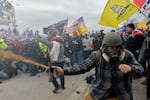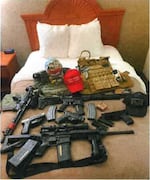
Trump supporters clash with police and security forces as people try to storm the U.S. Capitol Building in Washington, D.C., on January 6, 2021.
Joseph Prezioso
The 2024 presidential contest may be known as the “Jan. 6 election.”
Former President Donald Trump opened the first rally of his campaign by playing a rendition of the “Star-Spangled Banner” sung by riot defendants in jail — including an accused “Nazi sympathizer” and other defendants charged with assaulting police.
On Tuesday night, Vice President Kamala Harris made what her campaign called a “closing argument” at the Ellipse in Washington, D.C. It’s the same location where Trump spoke on Jan. 6, 2021, and told his supporters to “fight like hell” just before the assault on the Capitol began.
“We know who Donald Trump is,” Harris said. “He’s the person who stood at this very spot nearly four years ago and sent an armed mob to the United States Capitol to overturn the will of the people in a free and fair election.”
The FBI has classified the 2021 attack as an act of domestic terrorism that injured approximately 140 police officers and endangered the country’s peaceful transfer of power. In the immediate aftermath, a bipartisan group of political leaders condemned the violence. “American citizens attacked their own government. They used terrorism to try to stop a specific piece of domestic business they did not like,” said Sen. Mitch McConnell, the top Republican in the Senate. McConnell voted to acquit Trump of his second impeachment, but said “There is no question — none — that President Trump is practically and morally responsible for provoking the events of the day.”
Trump has rejected those arguments, and instead attempted to rewrite the history of the insurrection. He refers to Jan. 6 as a “day of love” and calls the rioters “patriots.” He has repeatedly promised to pardon those charged and convicted in connection with the attack, including those convicted of assaulting police.
With both Trump and Harris focused on the events of Jan. 6, NPR fact-checked some of the campaigns’ statements about that day.
The statement
“There were no guns down there. We didn’t have guns. The others had guns, but we didn’t have guns.” — Trump at a Univision town hall, Oct. 16, 2024
The facts
Court records indicate that, at a minimum, around 20 participants in the attack were armed with firearms, though it’s impossible to know the exact number, because law enforcement made so few arrests that day.
Guy Reffitt, the first person to go to trial for his role in the assault, brought a handgun to Capitol grounds and had an AR-15-style rifle in his hotel room. He belonged to a far-right militia group in Texas and recorded himself telling other Trump supporters on Jan. 6, “every one of my guys are here and I can assure you they came in hot.” He added, “you’re probably standing around more than a million-and-a-half guns right now.”

Prosecutors presented evidence that three rioters brought these weapons to a hotel room in Virginia before they joined the Jan. 6, 2021 riot at the U.S. Capitol. The men allegedly brought handguns with them onto the grounds of the U.S. Capitol.
Among the other rioters who brought guns to Capitol grounds were Mark Mazza, who pleaded guilty to carrying two loaded handguns; Jerod Thomas Bargar, who pleaded guilty to carrying a loaded handgun; Christopher Alberts, a former National Guardsman, who was convicted of assaulting police while dressed in body armor and carrying a loaded handgun; Jason Parsons, who pleaded guilty to carrying a Glock handgun; and Roger Preacher, who pleaded guilty to carrying a .22 caliber handgun.
Federal prosecutors allege that John Banuelos climbed scaffolding outside the Capitol building during the riot and fired his handgun into the air twice. He has pleaded not guilty.
The statement
“Why are they still being held? Nobody’s ever been treated like this. Nobody’s ever. Maybe the Japanese during the Second World War, frankly.” — Trump on the Dan Bongino Show, Oct. 18, 2024
The facts
Trump appears to be referring to the U.S. government’s internment of people of Japanese ancestry after Japan’s attack on Pearl Harbor and the country’s entry into World War II.
During the war, the U.S. government forcibly relocated more than 100,000 people living in the country and detained them in “relocation centers” simply due to their Japanese ancestry. The majority of those incarcerated were U.S. citizens. “Living conditions in these makeshift camps were terrible,” according to the National WWII Museum. “One assembly center established at Santa Anita Park, a racetrack in southern California, housed entire families in horse stalls with dirt floors.”
In 1988, Congress formally apologized for internment, saying it was “motivated by racial prejudice, wartime hysteria, and a failure of political leadership.”
By contrast, all of the people locked up in connection with the Jan. 6 attack have been charged with crimes. Federal prosecutors have charged more than 1,500 defendants, and most of them have opted to plead guilty for their role in the riot. In the cases that have gone to trial, prosecutors have an almost perfect record of winning convictions.
NPR’s analysis of the Jan. 6 cases has found that the median sentence imposed by judges is less than a year in jail. In about a third of cases that have reached the sentencing phase, the defendants have received no jail time at all. Enrique Tarrio, the former leader of the far-right group known as the Proud Boys, received a sentence of 22 years in prison, the longest of any Jan. 6 defendant, after being convicted of seditious conspiracy against the United States.
Japanese American leaders have condemned Trump’s remarks about Japanese internment
Filmmaker Sharon Yamato, whose parents were incarcerated as part of the internment policy, told the Associated Press, “Japanese Americans are not and should not be compared to insurrectionists who committed major crimes.”
The statement
“This is a person, Donald Trump, who tried to undo a free and fair election, who still denies the will of the people, who incited a violent mob to attack the United States Capitol and 140 law enforcement officers were attacked, some were killed.” — Harris on NBC News, Oct. 22, 2024
The facts
According to the U.S. Attorney’s Office for the District of Columbia, “Approximately 140 police officers were assaulted on Jan. 6 at the Capitol, including about 80 from the U.S. Capitol Police and about 60 from the Metropolitan Police Department.”
Among those injured was Capitol Police Officer Brian Sicknick, who was assaulted with pepper spray during the riot. Later that day, he collapsed and was taken to a hospital. He died on Jan. 7, 2021. The Office of the Chief Medical Examiner in Washington, D.C. determined that Sicknick suffered two strokes and died of natural causes, while also noting “all that transpired played a role in his condition.”
Sicknick’s family has blamed his death on the rioters who participated in the insurrection.
“All of you are culpable in Brian’s death,” Sicknick’s mother, Gladys, wrote in a victim impact statement as part of the case against one of the men who attacked her son. “All of you bear responsibility for the injuries sustained by Brian’s fellow officers — the broken bones, head trauma, and the continuing mental anguish they suffer — and will endure — for the rest of their lives.”
She added, “Lawlessness, misplaced loyalty, and hate, killed my son.”
Gladys Sicknick appeared at the Democratic National Convention along with her son Craig Sicknick.
Two other police officers who defended the Capitol on Jan. 6, Jeffrey Smith and Howard Liebengood, died by suicide in the days immediately after the attack. The Department of Justice formally classified their deaths as “in the line of duty.”
Smith’s wife Erin told NBC News, “I knew from the beginning that Jeffrey died in the line of duty from the injuries he suffered on January 6th.”
Attorney General Merrick Garland spoke about Liebengood in January at an event for a foundation set up in his memory.
“Officer Liebengood defended the United States Capitol, the people inside, and our very democracy on January 6,” said Garland. “He lost his life in the line of duty.”